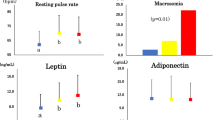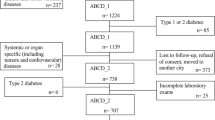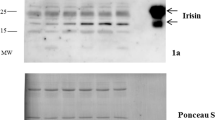Abstract
INTRODUCTION: Leptin (the product of the human OB gene) is increased in obese individuals, suggesting resistance to its effect. However, there is considerable variability in leptin levels at each level of body mass index (BMI), suggesting that genetic and environmental factors may regulate leptin concentrations. Previous data have suggested that leptin levels are associated with insulin resistance and in a few reports with impaired insulin secretion. We examined whether non-diabetic subjects, with elevated specific insulin and proinsulin levels, had increased leptin levels.
METHODS: We used a radioimmunoassay (RIA) to measure serum leptin levels in 197 non-diabetic Mexican Americans and non-Hispanic whites from the San Antonio Heart Study. We also evaluated whether leptin levels were associated with impaired insulin secretion or increased beta cell stress, as evaluated by the fasting proinsulin/insulin ratio. (Higher fasting proinsulin/insulin ratios are thought to reflect impaired insulin secretion.)
RESULTS: Leptin levels were significantly correlated with fasting specific insulin (r=0.55, P<0.001) and proinsulin (r=0.57, P<0.001) and inversely with the proinsulin/insulin ratio (r=−0.154, P=0.035) after adjustment for age, gender, ethnicity and 2 h glucose. These associations were similar in men and women and in Mexican Americans and in non-Hispanic whites. After further adjustment for BMI and waist-to-hip ratio (WHR), leptin levels remained significantly correlated with specific insulin (r=0.31, P<0.001) and proinsulin (r=0.24, P<0.001) although the magnitude of the associations were considerably attenuated.
CONCLUSION: We conclude that specific insulin and proinsulin are positively related to leptin levels and that these associations are to some degree independent of obesity and body fat distribution. Thus, subjects with increased insulin levels may be relatively resistant to the effects of leptin. However, leptin levels are associated with a decrease in the fasting proinsulin/insulin ratio suggesting that leptin levels are not associated with an impairment in insulin secretion.
This is a preview of subscription content, access via your institution
Access options
Subscribe to this journal
Receive 12 print issues and online access
$259.00 per year
only $21.58 per issue
Buy this article
- Purchase on Springer Link
- Instant access to full article PDF
Prices may be subject to local taxes which are calculated during checkout
Similar content being viewed by others
Author information
Authors and Affiliations
Rights and permissions
About this article
Cite this article
Haffner, S., Miettinen, H., Mykkänen, L. et al. Leptin concentrations are associated with higher proinsulin and insulin concentrations but a lower proinsulin/insulin ratio in non-diabetic subjects. Int J Obes 22, 899–905 (1998). https://doi.org/10.1038/sj.ijo.0800679
Received:
Revised:
Accepted:
Published:
Issue Date:
DOI: https://doi.org/10.1038/sj.ijo.0800679
Keywords
This article is cited by
-
Insulin resistance induces hyperleptinemia, cardiac contractile dysfunction but not cardiac leptin resistance in ventricular myocytes
International Journal of Obesity (2003)
-
Leptin plasma concentrations are dependent on body fat distribution in obese patients
International Journal of Obesity (2000)



